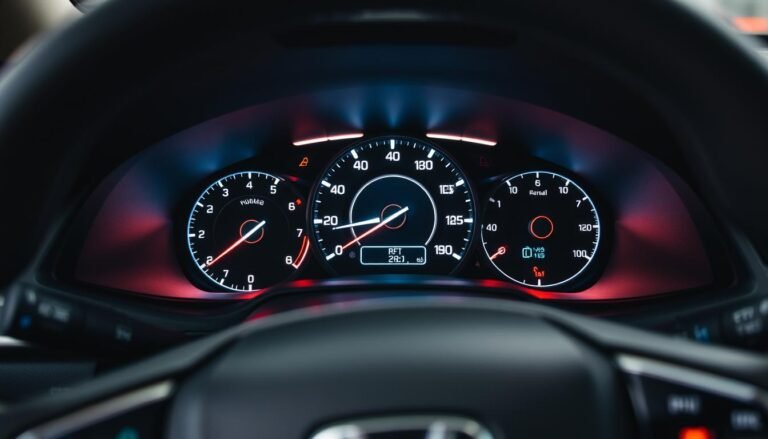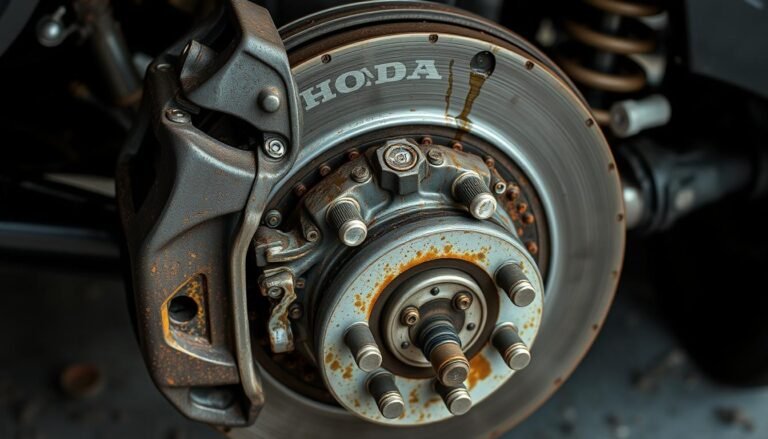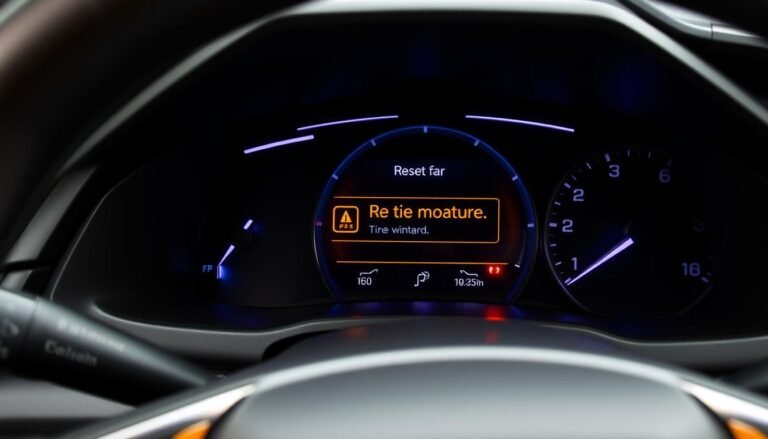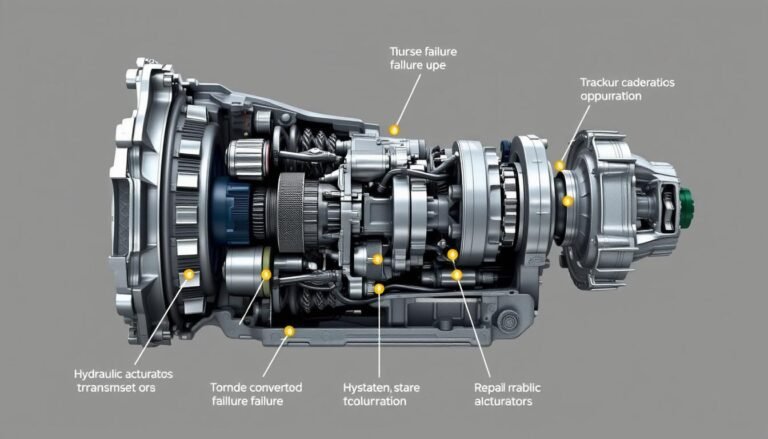Honda Pilot Maintenance Schedule Guide & Tips
What’s the maintenance schedule for the Honda Pilot? It’s important to follow the recommended service times to make sure your vehicle performs well for a long time.
This guide gives you all the details on the best care for your Honda Pilot. It covers everything from oil changes, brake checks, to tire maintenance, helping your SUV run smoothly.
In this Honda Pilot maintenance guide, you’ll not only find out the best times to service your car. You’ll understand why these maintenance periods are crucial.
Following these important recommendations will make your Pilot more reliable and valuable.
Get ready to keep your Honda Pilot in great shape with practical advice and schedules suited for all kinds of driving.
Introduction To Honda Pilot Maintenance
Keeping your Honda Pilot in top shape is vital for its best performance and life span. By keeping up with regular maintenance, you stop big problems before they start.
Getting to know the service needs of your honda pilot helps you keep it running well. You’ll need to change fluids, swap out filters, and get your vehicle checked.
Knowing when and how to do these things is key. Having a regular maintenance plan means you’re always one step ahead in taking care of your Honda Pilot.
What is The Importance of A Maintenance Schedule
A well-structured maintenance schedule is crucial for your Honda Pilot’s condition.
Adhering to a Honda Pilot maintenance plan cuts down unexpected breakdowns and expensive repairs.
Neglecting routine tasks could hurt your car’s long-term health and performance. Ignoring the recommended maintenance can cause problems.
You might see less fuel efficiency, reliability issues, and safety risks. Sticking to the Honda Pilot’s recommended maintenance boosts functionality and preserves its value.
A detailed maintenance schedule helps you catch problems early, keeping your Honda Pilot safe and efficient.
Taking time for regular checks and services makes driving smoother and more pleasant.
Honda Pilot Maintenance Schedule
Keeping a regular service schedule for your Honda Pilot is key to its performance and life span. It is important to follow the service intervals recommended for the Honda Pilot.
This ensures all crucial maintenance tasks are done on time. Here are the key service milestones you should know about to keep your car running well.
Recommended Service Intervals
| Mileage | Service Task |
|---|---|
| 7,500 miles | Replace engine oil and rotate tires. |
| 15,000 miles | Replace oil filter; inspect brakes, suspension, and various fluid levels. |
| 30,000 miles | More in-depth inspections; potential replacements of air cleaner elements and spark plugs. |
| 45,000 miles | Continue checking fluid levels; inspect belts and hoses. |
| 60,000 miles | Comprehensive maintenance check and replacement of additional components. |
Major Maintenance Milestones
Aside from regular oil changes and tire rotations, there are important maintenance tasks at specific times. These are essential for smooth operation of your Honda Pilot.
They include checks and possibly changing key parts to avoid bigger problems later.
Keeping a detailed record of these service tasks, as recommended by the manufacturer, helps your car stay in top shape.
Engine Oil Maintenance and Intervals
Keeping the right amount of engine oil is key for your Honda Pilot’s performance and life span.
The Honda Pilot maintenance checklist helps you remember when to service your car, including oil changes.
Changing your oil regularly boosts engine efficiency and avoids damage later.
Oil Change Frequency
How often you need to change your oil depends on how you drive. For many folks, changing the oil every 7,500 miles is good under normal use.
But if you’re often in harsh conditions—like hot or cold weather or lots of short drives—you should change it every 5,000 miles. Doing this keeps your Honda Pilot running well.
Selecting The Right Oil
It’s important to use the right oil in your Honda Pilot. You should use 0W-20 full synthetic oil.
This kind of oil protects your engine better and can help your car use less gas. It keeps your engine working smoothly in different driving situations.
| Driving Conditions | Recommended Oil Change Interval | Oil Type |
|---|---|---|
| Normal Conditions | Every 7,500 miles | 0W-20 Full Synthetic |
| Severe Conditions | Every 5,000 miles | 0W-20 Full Synthetic |
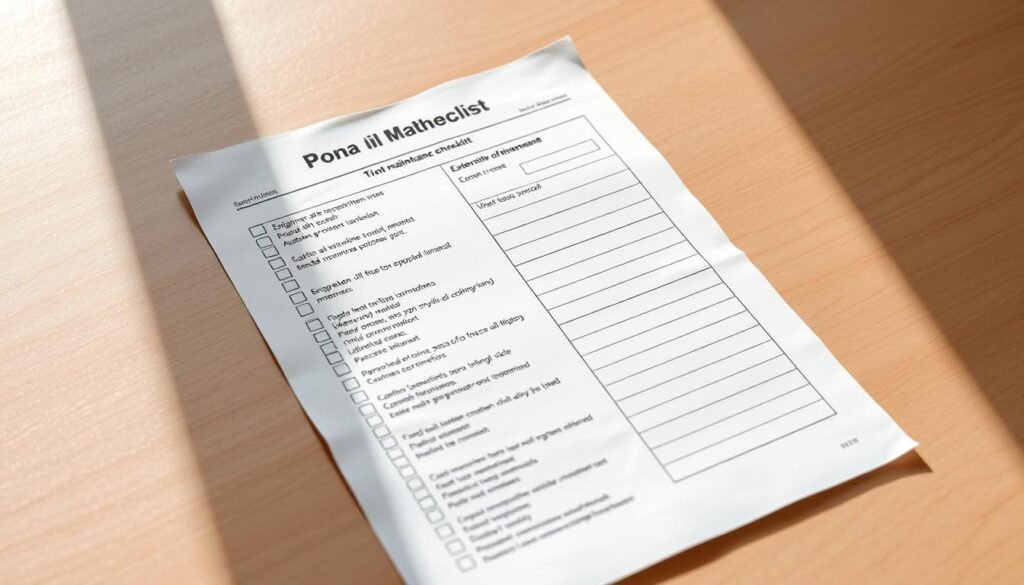
Transmission Fluid and Maintenance Recommendations
The transmission fluid is key for your Honda Pilot’s automatic transmission to work smoothly.
Regular checks and maintenance are crucial for its longevity and better performance. It’s wise to inspect and change the fluid every 30,000 miles, especially if you often drive under heavy loads or in tough conditions.
If you notice a burnt smell, dark fluid, or gear shifts slipping, these are signs the fluid is going bad.
Using the fluid Honda recommends can really help your car run better and respond quicker.
For every Honda Pilot owner, making sure these honda pilot maintenance tasks are a priority can really boost how well your vehicle drives and its reliability.
To get the best results, here are some steps to follow:
- Check transmission fluid levels regularly.
- Change the fluid based on the recommended mileage or when you notice signs of degradation.
- Use only Honda-recommended transmission fluid for best outcomes.
Keeping up with these tips can keep your vehicle’s transmission in top shape. Taking action now can save you from expensive fixes down the road.
Brake Fluid and Brake Maintenance
Keeping your brakes in good shape is crucial for safe driving. Getting to know the honda pilot maintenance guide is a big help in keeping your car running well.
We’ll look into how to manage brake fluid and do brake checks, which are key for any Honda Pilot owner.
Brake Fluid Replacement Schedule
Over time, brake fluid pulls in moisture, which harms braking power. It’s wise to change the brake fluid every three years, mileage doesn’t matter.
Doing this keeps your brakes working right and keeps you safe.
Inspecting and Maintaining Brakes
Making sure your brake pads and rotors are okay is vital for your Honda Pilot. This makes sure your brakes work well.
You should check:
- Brake pad thickness – replace thin pads to keep good stopping power.
- Rotor condition – look for any warping or damage.
- Fluid levels – keep brake fluid levels topped up.
- No leaks – make sure there are no leaks in the brake lines.
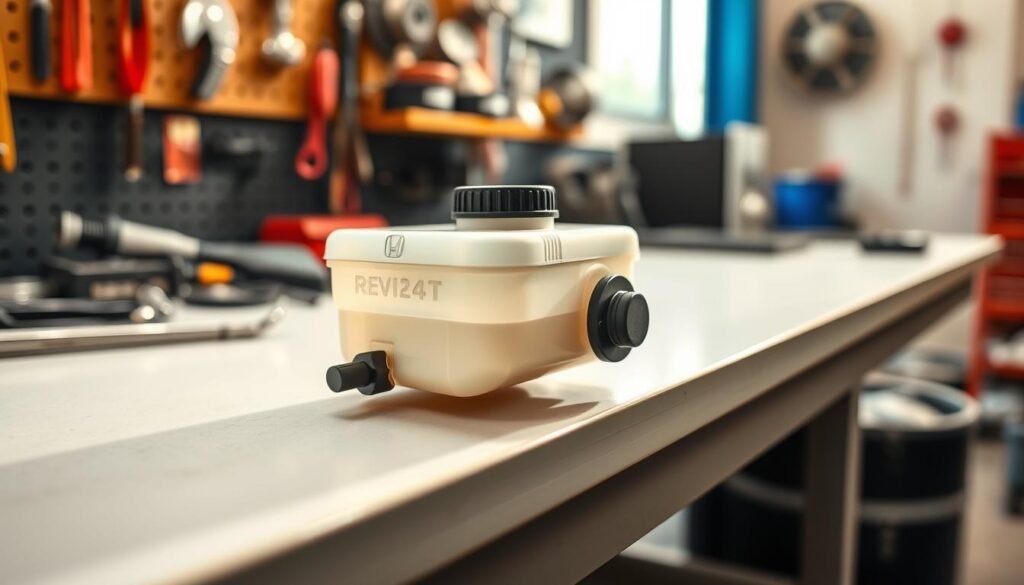
Honda Pilot Tire Care and Rotation Schedule
Keeping your tires in good shape is key to staying safe and making them last longer. Following a strict Honda Pilot maintenance plan keeps your ride smooth.
It’s crucial to check your tire’s air and tread often to avoid any trouble. Every 5,000 to 7,500 miles, you should rotate your tires.
This helps them wear down evenly, improving how your car handles and making your tires last longer.
Checking your Honda Pilot’s tire pressure every month is important for keeping them perfect. If tires are not properly inflated, you’ll use more gas, and your tires might wear out unevenly.
Also, it’s vital to look over your tires for any damage like cuts or bulges to stay safe while driving.
| Task | Frequency | Notes |
|---|---|---|
| Check Tire Pressure | Monthly | Adjust to recommended PSI |
| Rotate Tires | Every 5,000 to 7,500 miles | Promotes even wear |
| Inspect Tires for Damage | Every 1,000 miles | Look for cuts, punctures, or bulges |
| Check Tread Depth | Every 5,000 miles | Use a tread depth gauge for accuracy |
Air and Cabin Filter Replacement Guidelines
Keeping the air quality inside your Honda Pilot top-notch is important. You need to replace both the engine air filter and the cabin air filter regularly.
It’s usually good to swap out the engine filter every 15,000 to 30,000 miles. If you drive in dusty or polluted areas often, check it more often.
The air quality inside your car also hinges on the cabin air filter. If you drive in cities a lot, you should check this filter often.
A dirty cabin air filter can make the air inside your car worse. It’s crucial to keep it clean.
| Type of Filter | Recommended Replacement Interval | Driving Conditions Impact |
|---|---|---|
| Engine Air Filter | 15,000 – 30,000 miles | Replace sooner in dusty environments |
| Cabin Air Filter | 12,000 – 15,000 miles | Check more often in urban settings |
By following these tips, your Honda Pilot will run smoothly and the air will stay fresh.
Replacing filters on time is part of the recommended honda pilot service intervals. This practice boosts your car’s performance.
Coolant and Fluid Flush Recommendations
Keeping the right coolant level is key to stop your engine from getting too hot and breaking. For your Honda Pilot, it’s vital to follow the service schedule closely.
You should flush and replace the coolant every 60,000 miles. Doing this keeps your cooling system working well, so your car runs smoothly.
It’s not just about the coolant. You also need to keep an eye on other essential fluids. These fluids are:
- Brake fluid
- Transmission fluid
- Power steering fluid
Making sure these fluids are filled right is very important for your car to last longer.
When you check your Honda Pilot service schedule, remember to look at these fluids during your regular car checkups.
Being proactive like this can help you dodge sudden car troubles and make your car more reliable.
Maintenance Tips For Severe Driving Conditions
Driving in tough conditions needs more care for your Honda Pilot. Frequent short trips, very hot or cold weather, or pulling heavy stuff makes it important to adjust your honda pilot maintenance checklist.
This ensures your car works well for a long time. Here are some special tips for keeping your car in top shape under these hard conditions:
- Change oil more often: Your oil gets worn out quicker in tough conditions. It’s best to change your oil every 3,000 to 5,000 miles, not the usual time.
- Keep an eye on fluid levels: Always check and fill up important fluids like coolant, brake fluid, and transmission fluid. Hard conditions use up these fluids faster.
- Check your tires: Rough driving can wear out tires unevenly. Make sure your tire pressure is right and rotate your tires every 5,000 miles to dodge problems.
- Look after your brakes: If you often tow heavy things, you should check your brakes more often. This keeps them working right and keeps you safe.
- Swap out filters more: Put in new air and cabin filters more often to keep air flowing well in dusty or dirty places.
By making these changes to your honda pilot maintenance checklist, you’ll make your driving smoother and avoid car troubles.
Paying attention to the hard conditions your car goes through means you can take better care of it. This makes your Honda Pilot more reliable.
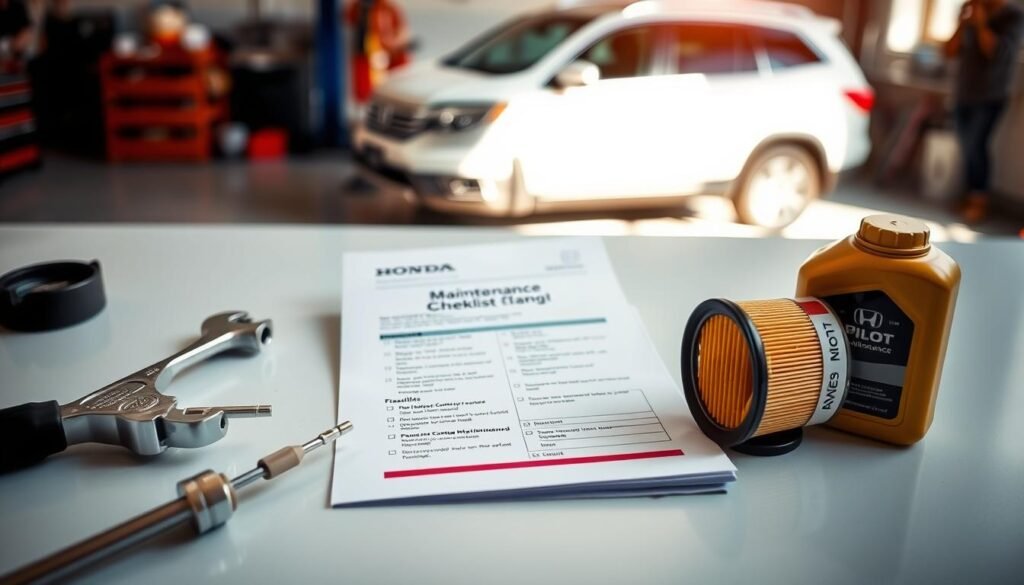
| Severe Condition | Recommended Change Interval |
|---|---|
| Short trips or stop-and-go driving | Oil change every 3,000 – 5,000 miles |
| Extreme temperatures | Check fluids every month |
| Towing heavy loads | Brake inspection every 5,000 miles |
| Dusty or polluted environments | Change filters every 10,000 miles |
Utilizing The Maintenance Minder System
The Honda Pilot comes with a Maintenance Minder system to keep you updated on car care. It looks at how you drive and tells you when service is needed.
This helps keep your car running well, lasts longer, and performs better. It’s important to know what the alerts mean. The system uses letters and numbers for different services.
For example, “A” means it’s time for an oil change, while other letters point to different checks and replacements. Checking these alerts helps you follow the honda pilot maintenance guide.
To use the Maintenance Minder system well, here are some tips:
- Look at the maintenance alerts every month.
- Understand the service suggestions given.
- Book a service as soon as you get an alert.
- Keep track of services to stay on top of maintenance.
Taking care of maintenance early stops big problems and expensive fixes later. Using the Maintenance Minder keeps your Honda Pilot dependable and in top shape.
Common Honda Pilot Maintenance Tasks
Keeping your Honda Pilot in good shape is key to making sure it lasts a long time and runs well. It’s important to stick to a maintenance schedule.
This will help you catch problems early and avoid big repairs. Here is a handy checklist to track the essential tasks to follow the Honda Pilot’s recommended maintenance plan.
Checklist For Regular Maintenance
- Engine Oil Change – Every 5,000 to 7,500 miles
- Transmission Fluid Check – Every 30,000 miles
- Brake Fluid Replacement – Every 2 years
- Cabin Filter Replacement – Every 15,000 to 30,000 miles
- Air Filter Replacement – Every 30,000 miles
- Tire Rotation – Every 5,000 to 7,500 miles
- Coolant Fluid Flush – Every 60,000 miles
This checklist highlights the most important maintenance tasks for your Honda Pilot.
Following it ensures better performance and can save you from expensive fixes in the future.
Keeping up with these tasks helps keep your Pilot in top shape and operating smoothly.
| Maintenance Task | Frequency |
|---|---|
| Oil Change | 5,000 – 7,500 miles |
| Transmission Fluid Check | 30,000 miles |
| Brake Fluid Replacement | Every 2 years |
| Cabin Filter Replacement | 15,000 – 30,000 miles |
| Air Filter Replacement | 30,000 miles |
| Tire Rotation | 5,000 – 7,500 miles |
| Coolant Fluid Flush | 60,000 miles |
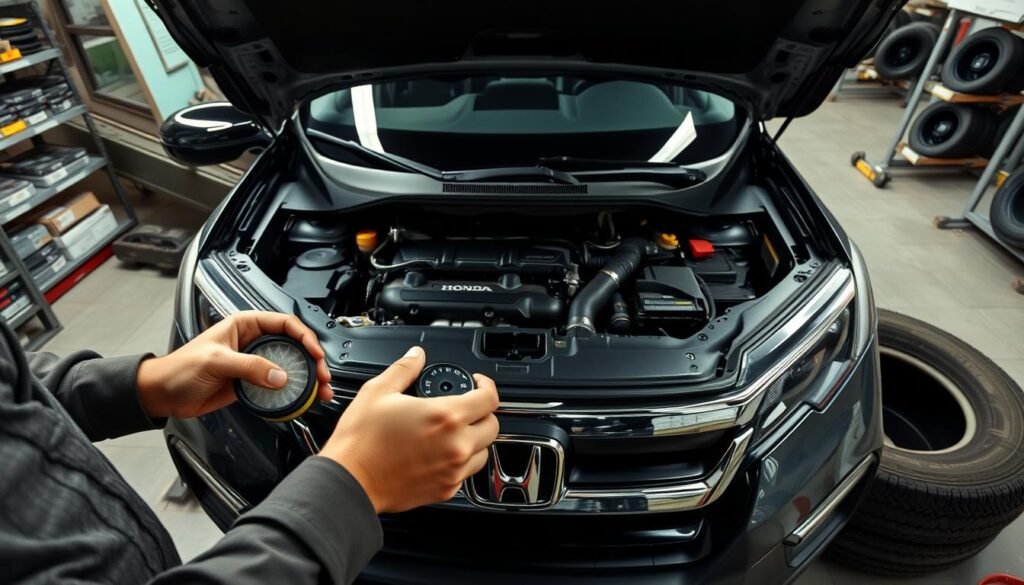
Conclusion
Keeping up with a honda pilot maintenance schedule is key for your car’s performance and long life.
By sticking to the service times mentioned in this guide, you can stop small problems from becoming big expenses.
Doing regular checks, changing fluids, and replacing filters will keep your Honda Pilot in top shape.
Also, knowing what your Honda Pilot specifically needs means you can adjust your care plan.
Whether it’s everyday driving or something more intense, sticking to these tips will keep your car running well.
Taking good care of your Honda Pilot will make it reliable, efficient, and a joy to drive. Stay on top of your maintenance to enjoy your car’s dependable performance.
FAQs
Q: What is the recommended oil change interval for a Honda Pilot?
A: Change the engine oil every 7,500 miles under normal driving conditions. Under severe conditions, change it every 5,000 miles.
Q: How often should I replace the transmission fluid?
A: Check and change the transmission fluid every 30,000 miles. This is crucial if you drive under heavy-load or severe conditions often.
Q: When should I replace the brake fluid in my Honda Pilot?
A: Replace brake fluid every three years, no matter the mileage. Over time, brake fluid can absorb moisture and affect performance.
Q: How often should I rotate my tires?
A: Rotate your tires between every 5,000 to 7,500 miles. This helps them wear evenly and last longer.
Q: What maintenance tasks should I prioritize for optimal performance?
A: For optimal performance, focus on regular oil changes, brake checks, tire rotations, and fluid level checks. This keeps your vehicle running smoothly.
Q: What is the importance of the Maintenance Minder system in my Honda Pilot?
A: The Maintenance Minder system reminds you when your vehicle needs maintenance. It tracks your driving habits to notify you about fluid and service needs.
Q: How can I adjust my maintenance schedule for severe driving conditions?
A: If you often face severe driving conditions, change your oil more often. Also, keep a close watch on fluid levels.



